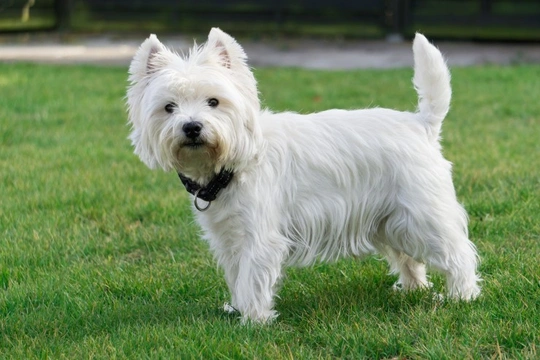
Westie Skin Problems: Pictures, Issues & Treatment
The West Highland Terrier or “Westie” is a small breed of terrier that hails from Scotland, and is distinctive for its all-white coat. They are similar in build and general appearance to the Scotty dog or Scottish Terrier, aside from the fact that the Westie is always white and the Scotty is always black!
As small, intelligent, lively and active dogs they are popular family pets, and good with people of all ages. They are also relatively robust and healthy little dogs, but they do have a well-known propensity to suffer from a range of problems with the skin and coat, which can prove problematic for their owners and uncomfortable for the dogs themselves.
Read on to learn more about some of the common skin problems that affect the West Highland Terrier, plus more information about their general health.
West Highland Terrier breeding and longevity
Westies usually produce litters of between three and five puppies, although larger litters are not at all uncommon. Breeding and giving birth tend to be relatively problem-free among the breed, and generally, all of the resultant puppies are live born and healthy.
The average lifespan of the Westie is between eleven and fifteen years according to UK breed data, with most West Highland Terriers reaching towards the top of this range, and sometimes, of course, living much longer!
General Westie health issues
While the West Highland Terrier is a relatively long-lived breed, they are nevertheless prone to a range of genetically inherited health issues. One of the most prevalent of these conditions is issues with the skin and coat, and we will cover this in more detail in the next section. Skin problems aside, the conditions that Westies have a heightened propensity to be affected by include:
- “Westie jaw,” or to give it its proper name, craniomandibular osteopathy, which will be present in puppies if both parents carry the gene for the condition. It causes the bones of the jaw to thicken, and calcium and enzyme levels within the bloodstream may be higher than normal too. The condition progresses between birth and one year of age, at which point it may naturally recede. However, if this does not occur, the pain and associated problems with feeding that the condition causes may lead to the need for euthanasia of the dog.
- Globoid cell leukodystrophy is another condition that may affect Westies (as well as other breeds) which is a neurological condition that leads to muscle weakness, tremors and gradual paralysis.
- White dog shaker syndrome can also affect Westies, as well as many other breeds, not all of which are white! This condition leads to tremors and ataxia in the dog. In male dogs, the condition is usually lifelong, but in females, it is usually only symptomatic for four to six weeks.
- Hip joint problems, specifically the condition known as Legge-Calve-Perthes syndrome, may also affect Westies, although there are many other breeds with much higher risk factors for the condition.
West Highland Terrier skin disorders
West Highland Terriers are known to be at risk for various skin disorders of different types, and the occurrence of skin and coat problems as a whole within the breed is much higher than it is for most other breeds.
- Atopic dermatitis is an uncomfortable and ongoing condition that affects 25% or more of all Westies, with male dogs of the breed more likely to be affected than females.
- Hyperplastic dermatosis is another condition associated with the Westie, and one that is not known to affect any other breed of dog. While the condition is not particularly prevalent within the breed as a whole, the condition, when present, is rather severe. Sometimes the condition is misdiagnosed as a simple allergy or general dermatitis in the early stages, as the condition is progressive.
Symptoms of the condition include hair loss, red hyperpigmentation of the fur (the fur taking on a reddish tinge) and scaly lesions of the skin that are known as lichenification. Hair loss is often associated with the condition, and the appearance of the skin underneath is often rough, scaly, lumpy and uncomfortable-looking, and very dry. If hair loss is not present, sometimes, the affected areas are shaved in order to gain better access to the affected skin. Generally, the skin along the dog’s back is the most likely to be affected with hyperplastic dermatosis.
Caring for a Westie with skin problems is an ongoing process, which may require regular medicated baths, application of skin ointments and moisturisers, and other care. If you suspect that your Westie might be suffering from a skin condition, or they appear to be particularly itchy or prone to dry skin, it is important to take your dog along to the vet to get a firm diagnosis, and establish the best way to proceed with treatment.



